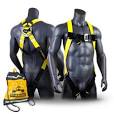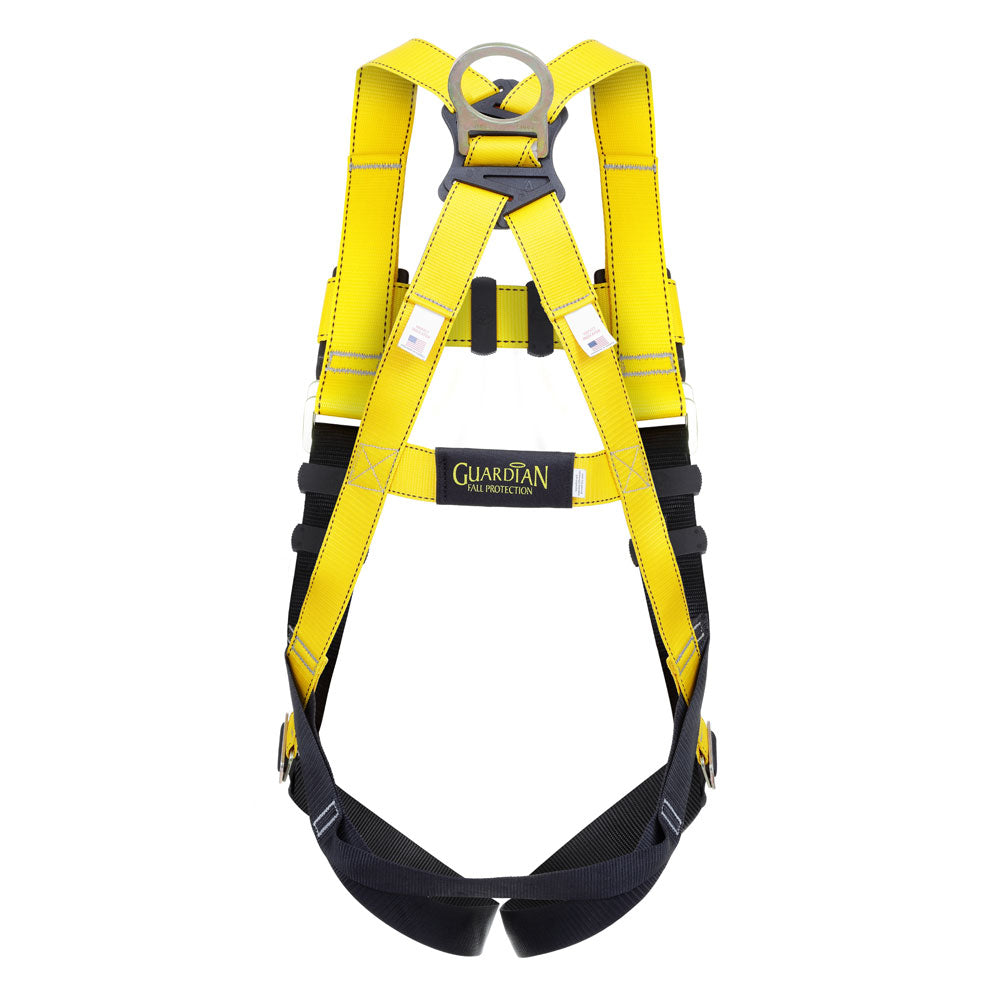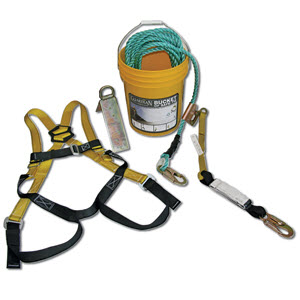The Importance of Safety Harness and Lanyard in Workplace Safety
When it comes to working at heights or in hazardous environments, safety should always be the top priority. One essential piece of safety equipment that plays a crucial role in preventing falls and injuries is the safety harness and lanyard.
What is a Safety Harness and Lanyard?
A safety harness is a form of protective equipment designed to secure a person to prevent falls or limit the impact of a fall. It typically consists of straps that fasten around the torso, shoulders, and legs, distributing the force of a fall across the body.
A lanyard is a flexible line that connects the safety harness to an anchor point or lifeline. It acts as a shock absorber, reducing the impact on the body in case of a fall.
The Role of Safety Harness and Lanyard in Workplace Safety
For workers who perform tasks at heights, such as construction workers, window cleaners, or roofers, wearing a safety harness and lanyard can mean the difference between life and death. These essential pieces of equipment provide vital protection against falls and help ensure that workers can perform their duties safely.
By properly securing a safety harness and lanyard to an anchor point that can support their weight, workers have an added layer of protection in case they lose their balance or slip while working at heights. The lanyard’s shock-absorbing properties help reduce the impact forces on the body during a fall, minimizing the risk of serious injury.
Training and Proper Use
It is not enough to simply provide safety harnesses and lanyards to workers; proper training on how to use them correctly is essential. Workers must understand how to inspect their equipment for wear and tear, properly fit their harnesses, connect them securely to anchor points, and ensure that there is no slack in the lanyard that could lead to excessive free fall distance.
Regular inspections of safety harnesses and lanyards should also be conducted to identify any signs of damage or wear that could compromise their effectiveness. Employers must enforce strict guidelines regarding the use of this equipment to maintain a safe working environment for all employees.
In Conclusion
Safety harnesses and lanyards are indispensable tools for ensuring workplace safety in environments where falls are a significant risk. By providing workers with high-quality equipment, thorough training, and enforcing proper usage protocols, employers can significantly reduce the likelihood of accidents and injuries while promoting a culture of safety on site.
Essential FAQs on Safety Harnesses and Lanyards: Usage, Fitting, and Regulations
- 1. What is a safety harness and lanyard?
- 2. Why is it important to wear a safety harness and lanyard?
- 3. How do I properly fit a safety harness?
- 4. What type of anchor points can be used with a safety harness and lanyard?
- 5. How often should safety harnesses and lanyards be inspected?
- 6. What are the key features to look for when selecting a safety harness and lanyard?
- 7. Are there specific regulations or standards that govern the use of safety harnesses and lanyards?
1. What is a safety harness and lanyard?
A safety harness and lanyard are essential pieces of protective equipment used in various industries to prevent falls and minimize the impact of falls in hazardous work environments. A safety harness is a system of straps that secure around the body, typically the torso, shoulders, and legs, to distribute the force of a fall across the body. On the other hand, a lanyard is a flexible line that connects the safety harness to an anchor point or lifeline. The combination of a safety harness and lanyard provides workers with crucial support and protection when working at heights or in situations where falls are a risk, ensuring their safety while on the job.
2. Why is it important to wear a safety harness and lanyard?
Wearing a safety harness and lanyard is crucial for personal protection when working at heights or in hazardous environments. These safety devices serve as a lifeline that prevents falls and minimizes the impact of a fall if one occurs. By securing oneself with a safety harness and lanyard connected to a stable anchor point, workers significantly reduce the risk of serious injuries or fatalities in the event of an accidental slip or fall. The proper use of safety harnesses and lanyards is not just a precautionary measure but a fundamental aspect of workplace safety protocols to ensure the well-being of individuals working in elevated or risky conditions.
3. How do I properly fit a safety harness?
Properly fitting a safety harness is crucial to ensure its effectiveness in preventing falls and protecting the wearer in hazardous situations. To fit a safety harness correctly, start by adjusting the straps to ensure a snug but comfortable fit around the torso, shoulders, and legs. The harness should be secure but not overly tight, allowing for freedom of movement while maintaining proper positioning in case of a fall. It is essential to follow the manufacturer’s guidelines for fitting the harness and regularly inspect it for any signs of wear or damage that could compromise its integrity. Proper training on fitting and adjusting safety harnesses is essential to ensure that workers understand how to use this equipment effectively in their daily tasks.
4. What type of anchor points can be used with a safety harness and lanyard?
When considering the use of a safety harness and lanyard, it is crucial to select appropriate anchor points that can support the weight of the individual in the event of a fall. Common anchor points include fixed structural elements like beams, columns, or sturdy equipment specifically designed for anchoring purposes. Additionally, certified anchor points such as designated tie-off points or lifelines should be used to ensure maximum safety and compliance with regulations. Proper selection and inspection of anchor points are essential to guarantee the effectiveness of safety harnesses and lanyards in preventing falls and protecting workers at height.
5. How often should safety harnesses and lanyards be inspected?
Regular inspection of safety harnesses and lanyards is crucial to ensure their effectiveness in protecting workers from falls and injuries. According to safety regulations and industry best practices, safety harnesses and lanyards should be inspected before each use by the worker. Additionally, a more thorough inspection by a competent person should be conducted at least annually or more frequently based on the frequency of use, environmental conditions, and manufacturer recommendations. By adhering to a consistent inspection schedule, potential issues or wear and tear can be identified early, allowing for timely repairs or replacements to maintain the integrity of the safety equipment and uphold workplace safety standards.
6. What are the key features to look for when selecting a safety harness and lanyard?
When selecting a safety harness and lanyard, several key features are essential to ensure optimal protection and performance. Firstly, it is crucial to consider the fit of the harness, ensuring that it is adjustable and comfortable for the wearer. Look for harnesses with multiple attachment points to accommodate various work scenarios. The material of the harness should be durable and capable of withstanding the rigors of the work environment. Additionally, inspect the lanyard for shock-absorbing capabilities and length adjustability to minimize fall impact and provide flexibility during use. Lastly, verify that both the harness and lanyard meet relevant safety standards to guarantee their effectiveness in preventing falls and protecting workers in hazardous situations.
7. Are there specific regulations or standards that govern the use of safety harnesses and lanyards?
Yes, there are specific regulations and standards that govern the use of safety harnesses and lanyards to ensure workplace safety. Organizations such as OSHA (Occupational Safety and Health Administration) in the United States have established guidelines that outline the requirements for the proper selection, use, and maintenance of fall protection equipment, including safety harnesses and lanyards. These regulations detail criteria such as weight capacity, durability, anchorage strength, and inspection protocols to guarantee that workers are adequately protected when working at heights or in hazardous conditions. Adhering to these standards is crucial for employers and employees to maintain a safe work environment and prevent accidents related to falls.




